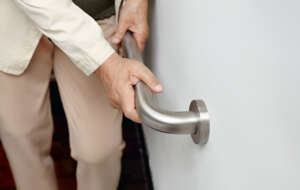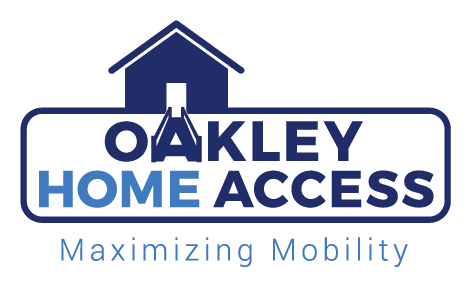Essential Fall Prevention Tips for Seniors
Key Takeaways
- Falls are the leading cause of serious injury among older adults—but they can be prevented with proactive measures.
- Common risk factors for older adult falls include age-related changes, medications, environmental factors, and chronic conditions.
- Home safety modifications like grab bars, slip-resistant backing, and proper lighting help prevent falls.
- Balance and strength exercises improve stability and reduce the risk of falling.
- Assistive equipment, including handrails, wheelchair ramps, and residential elevators, can enhance mobility and safety.
- Healthy habits such as proper hydration, vision checkups, and wearing non-skid footwear reduce fall risks.
- Emergency preparedness is essential—knowing what to do after a fall can prevent further injury.

Falls are a leading cause of serious injury among older adults, often resulting in hip fractures, hospitalizations, and long-term health complications. According to the National Center for Disease Control, older adult falls send millions to emergency departments every year, impacting their quality of life and independence.
The good news? Falls can be prevented. By understanding risk factors, improving home safety, and making healthy lifestyle choices, older adults can significantly reduce their risk of falling and continue living confidently.
This guide covers essential falls prevention tips, environmental factors that contribute to fall risks, and additional resources to help seniors stay safe.
Understanding the Risk Factors of Why Adults Fall
Older falls happen due to multiple risk factors that impact balance, mobility, and injury prevention.
Common Causes of Older Adult Falls
- Age-related changes – Muscle weakness, slower reflexes, and poor coordination increase the risk of falling
- Chronic diseases – Arthritis, diabetes, and osteoporosis affect mobility
- Medications – Some prescription drugs cause dizziness or drowsiness, increasing fall risk
- Environmental factors – Loose rugs, poor lighting, and clutter create tripping hazards
- Footwear issues – Stocking feet, high heels, and shoes without nonskid soles lead to slips
By addressing these risk factors, falls can be prevented and serious injuries reduced.
How to Make Your Home Safer
Your home should support injury prevention and fall safety rather than pose a risk of falling.
Room-by-Room Safety Checklist
- Living Room & Bedroom
- Remove loose rugs or secure them with slip-resistant backing
- Ensure furniture is stable and placed strategically to avoid tripping
- Improve lighting, especially in walkways
- Bathroom
- Install grab bars near the toilet and shower
- Use nonskid soles on bathroom mats
- Consider a walk-in tub or shower seat
- Kitchen
- Keep frequently used items within easy reach
- Wipe up spills immediately
- Avoid standing on chairs or unstable objects
- Stairs & Hallways
- Add handrails on both sides of the stairs
- Install motion sensor lights for night visibility
- Reduce clutter to minimize the risk of falling
Pro Tip: A wheelchair ramp or stair lift can significantly enhance fall prevention for seniors with mobility challenges.
Improve Balance & Strength to Prevent Falls
Exercise plays a vital role in falls prevention by improving balance, flexibility, and coordination.
Recommended Balance & Strength Exercises
- Balance Training
- Single-leg stance – Strengthens stability
- Heel-to-toe walk – Enhances coordination
- Side leg raises – Improves lower body strength
- Strengthening Exercises
- Chair squats – Builds leg muscles
- Wall push-ups – Strengthens arms and core
- Resistance band workouts – Increases flexibility
- Yoga & Tai Chi
- Helps older adults improve balance and reduce risk factors
Falls can be prevented with consistent strength-building activities.
Choosing the Right Assistive Equipment for Fall Prevention
For seniors with mobility concerns, assistive equipment ensures injury prevention and home safer modifications.
Essential Equipment for Fall Prevention
- Grab Bars & Handrails
- Installed in bathrooms, hallways, and staircases to reduce risk of falling. These essential tools provide older adults with the stability needed to move safely, especially in areas prone to slips and falls. Grab bars are particularly useful in the bathroom, where wet surfaces can increase the risk of an accident. Handrails in hallways and staircases offer support and balance, helping to prevent falls in these high-risk areas.
- Wheelchair Ramps & Threshold Ramps
- Provides accessibility and prevents tripping hazards. Wheelchair ramps are crucial for older adults who use wheelchairs or walkers, ensuring easy access to different levels of the home without the risk of tripping over thresholds. They also facilitate safe entry and exit from the home, which is essential for maintaining independence.
- Residential Elevators & Stair Lifts
- Great for multi-level homes where stairs increase the risk. These devices offer a safe and convenient way for seniors to navigate between floors, reducing the strain and danger associated with climbing stairs. Residential elevators and stair lifts are particularly beneficial for older adults with mobility issues, providing a secure means of transportation within the home.
- Adaptive Bathroom Equipment
- Raised toilet seats reduce strain when sitting and standing. This equipment is designed to make daily bathroom routines safer and more comfortable for older adults. Raised toilet seats minimize the effort needed to sit and stand, reducing the risk of falls. Shower chairs offer additional support, allowing seniors to bathe safely without the fear of slipping. Such adaptive equipment is
Installing these fall prevention tools significantly reduces the risk of injury for older adults.
Lifestyle & Health Tips to Reduce Fall Risk
Beyond home modifications, daily habits play a major role in falls prevention. Adopting a comprehensive lifestyle approach can significantly enhance safety and reduce the risk of falls among older adults.
Healthy Habits to Prevent Falls
- Eat for Stronger Bones
- Increase calcium and Vitamin D intake for hip fracture prevention. Incorporate foods like dairy products, leafy greens, and fortified cereals into your diet. Consider supplements after consulting with a healthcare provider to ensure adequate intake.
- Stay Hydrated
- Dehydration can cause dizziness and increase the risk of falling. Aim for at least 8 cups of water daily, and remember that hydration needs may vary based on activity level and climate. Herbal teas and water-rich fruits can also contribute to fluid intake.
- Regular Vision & Hearing Checkups
- Poor eyesight and hearing increase fall risk. Schedule annual eye exams and hearing tests to detect and correct any issues promptly. Proper eyewear and hearing aids can significantly improve spatial awareness and balance.
- Get Enough Sleep
- Fatigue leads to poor balance and coordination. Aim for 7-9 hours of sleep per night to ensure your body is well-rested. Establish a regular sleep routine by going to bed and waking up at the same time each day, and create a relaxing bedtime environment.
- Wear Proper Footwear
- Avoid stocking feet, high heels, and slippery shoes. Choose shoes with nonskid soles for added stability, and ensure they fit well to provide proper support. Consider footwear specifically designed for older adults to maximize comfort and reduce fall risk.
- Engage in Regular Physical Activity
- Incorporate activities like walking, swimming, or cycling into your routine to maintain strength and flexibility. Physical activity enhances muscle tone, balance, and overall health, reducing the likelihood of falls.
- Manage Medications
- Review your medications with a healthcare provider to identify any that may cause dizziness or drowsiness. Adjustments or alternatives may be available to minimize side effects that increase fall risk.
Small changes make a big impact on injury prevention and fall prevention for seniors. By integrating these healthy habits into daily life, older adults can enjoy improved safety and well-being.
What to Do After a Fall
If a fall occurs, knowing how to respond can prevent further injury. Having a clear emergency response plan in place ensures that older adults and their caregivers are prepared to act swiftly and effectively.
How to Get Up Safely After a Fall
- Stay calm and check for serious injuries. Take a moment to assess your condition and ensure there are no immediate dangers around you, such as sharp objects or unstable furniture.
- Roll onto your side and slowly get onto hands and knees. Move cautiously to avoid aggravating any injuries.
- Use a sturdy chair or grab bar for support to stand. Take your time and avoid sudden movements. If assistance is needed, call for help or use a medical alert device.
- Seek medical attention if experiencing dizziness or pain. Even if injuries seem minor, it’s important to get checked by a healthcare professional to rule out any underlying issues.
When to Visit Emergency Departments
- If experiencing hip fractures, swelling, or head injuries. These symptoms require immediate medical evaluation to prevent complications.
- If unable to stand or feeling disoriented. Seek emergency care to ensure safety and receive appropriate treatment.
Pro Tip: Consider a medical alert system for emergency assistance. These devices provide peace of mind by enabling quick access to help if a fall occurs, ensuring timely intervention and reducing the risk of further injury.
Conclusion
Falls remain a leading cause of serious injury among older adults, but the good news is that with proactive fall prevention strategies, falls can be prevented. By addressing key risk factors, making home safety modifications, and adopting healthy lifestyle habits, older adults can enhance their safety and maintain their independence.
Taking action today can significantly improve the safety and quality of life for older adults. Stay active, stay safe, and take control of your health journey with confidence!
Prevent Falls with Oakley Home Access in Rhode Island
Take proactive steps to secure your home and prevent falls with Oakley Home Access. Our specialized services offer essential fall prevention solutions, such as grab bars, wheelchair ramps, and other equipment to enhance safety and mobility for older adults.
Contact us today to find out how we can help you create a safer living environment!
FAQs
What are the most common causes of falls among older adults?
A combination of risk factors, including muscle weakness, balance issues, medications, vision impairments, and environmental hazards like loose rugs or poor lighting often causes falls in older adults. Addressing these factors is crucial in fall prevention.
What is the best way to prevent falls in the elderly?
The best way to prevent falls among older adults includes a mix of home safety modifications, such as installing grab bars and using slip-resistant backing, regular balance and strength exercises, and routine health checkups to manage medications and vision.
Is rolling out of bed considered a fall?
Yes, rolling out of bed is considered a fall. It highlights the importance of using assistive devices like bed rails or non-slip mats to prevent such incidents and ensure the safety of older adults.
What is the number one balance exercise for seniors?
One of the most effective balance exercises for seniors is the single-leg stance. This exercise helps improve stability and can be easily incorporated into daily routines to reduce the risk of falling.
